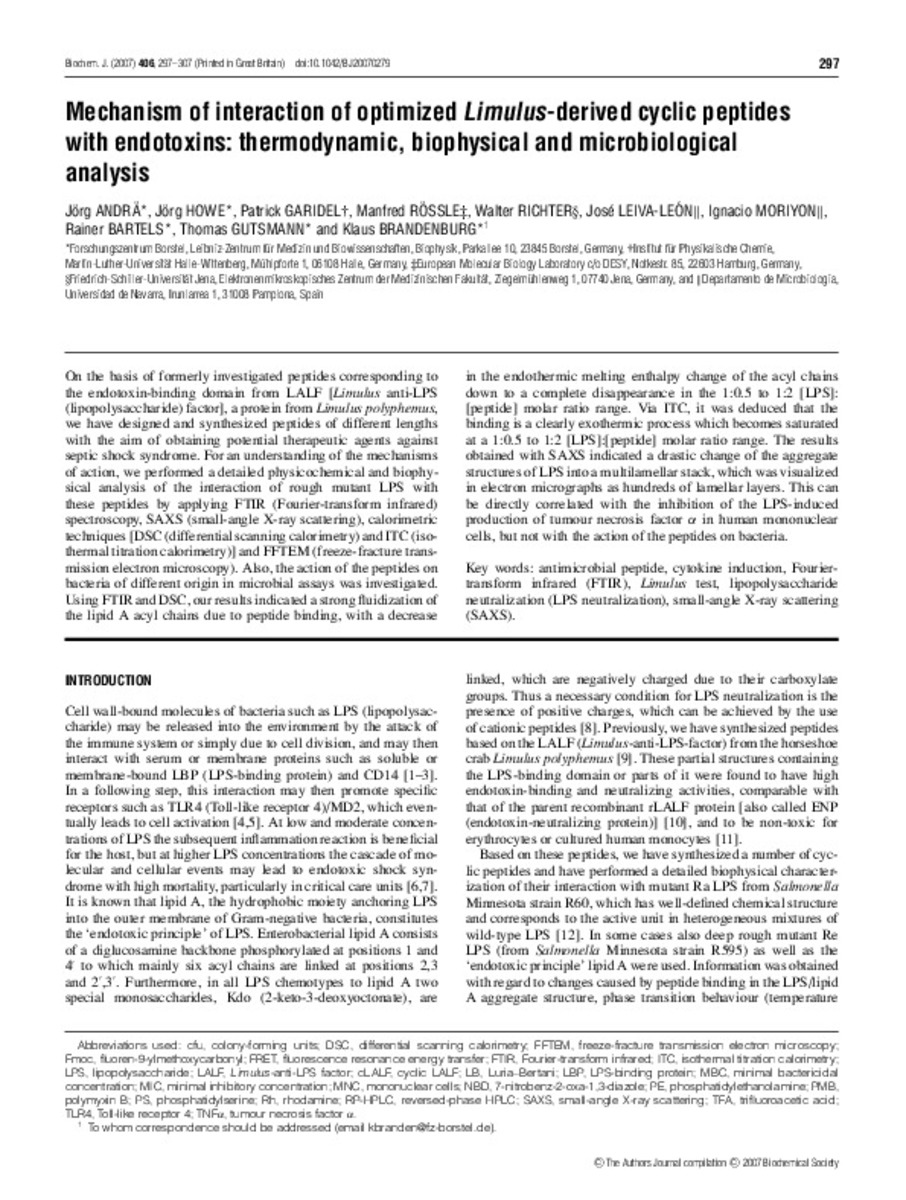Full metadata record
| DC Field | Value | Language |
|---|---|---|
| dc.creator | Andrä, J. (Jörg) | - |
| dc.creator | Howe, J. (Jörg) | - |
| dc.creator | Garidel, P. (Patrick) | - |
| dc.creator | Rossle, M. (Manfred) | - |
| dc.creator | Richter, W. (Walter) | - |
| dc.creator | Leiva, J. (José) | - |
| dc.creator | Moriyon, I. (Ignacio) | - |
| dc.creator | Bartels, R. (Rainer) | - |
| dc.creator | Gutsmann, T. (Thomas) | - |
| dc.creator | Brandenburg, K. (Klaus) | - |
| dc.date.accessioned | 2013-06-25T08:15:56Z | - |
| dc.date.available | 2013-06-25T08:15:56Z | - |
| dc.date.issued | 2007 | - |
| dc.identifier.citation | Andra J, Howe J, Garidel P, Rossle M, Richter W, Leiva-Leon J, et al. Mechanism of interaction of optimized Limulus-derived cyclic peptides with endotoxins: thermodynamic, biophysical and microbiological analysis. Biochem J 2007 Sep 1;406(2):297-307. | es_ES |
| dc.identifier.issn | 1470-8728 | - |
| dc.identifier.uri | https://hdl.handle.net/10171/29427 | - |
| dc.description.abstract | On the basis of formerly investigated peptides corresponding to the endotoxin-binding domain from LALF [Limulus anti-LPS (lipopolysaccharide) factor], a protein from Limulus polyphemus, we have designed and synthesized peptides of different lengths with the aim of obtaining potential therapeutic agents against septic shock syndrome. For an understanding of the mechanisms of action, we performed a detailed physicochemical and biophysical analysis of the interaction of rough mutant LPS with these peptides by applying FTIR (Fourier-transform infrared) spectroscopy, SAXS (small-angle X-ray scattering), calorimetric techniques [DSC (differential scanning calorimetry) and ITC (isothermal titration calorimetry)] and FFTEM (freeze-fracture transmission electron microscopy). Also, the action of the peptides on bacteria of different origin in microbial assays was investigated. Using FTIR and DSC, our results indicated a strong fluidization of the lipid A acyl chains due to peptide binding, with a decrease in the endothermic melting enthalpy change of the acyl chains down to a complete disappearance in the 1:0.5 to 1:2 [LPS]:[peptide] molar ratio range. Via ITC, it was deduced that the binding is a clearly exothermic process which becomes saturated at a 1:0.5 to 1:2 [LPS]:[peptide] molar ratio range. The results obtained with SAXS indicated a drastic change of the aggregate structures of LPS into a multilamellar stack, which was visualized in electron micrographs as hundreds of lamellar layers. This can be directly correlated with the inhibition of the LPS-induced production of tumour necrosis factor alpha in human mononuclear cells, but not with the action of the peptides on bacteria. | es_ES |
| dc.language.iso | eng | es_ES |
| dc.publisher | Portland Press | es_ES |
| dc.rights | info:eu-repo/semantics/openAccess | es_ES |
| dc.subject | Biophysics | es_ES |
| dc.subject | Endotoxins pharmacology | es_ES |
| dc.subject | Invertebrate hormones chemistry | es_ES |
| dc.subject | Peptides | es_ES |
| dc.subject | Cyclic chemistry | es_ES |
| dc.subject | Thermodynamics | es_ES |
| dc.title | Mechanism of interaction of optimized Limulus-derived cyclic peptides with endotoxins: thermodynamic, biophysical and microbiological analysis | es_ES |
| dc.type | info:eu-repo/semantics/article | es_ES |
| dc.type.driver | info:eu-repo/semantics/article | es_ES |
| dc.identifier.doi | http://dx.doi.org/10.1042/BJ20070279 | es_ES |
Files in This Item:
Statistics and impact
Items in Dadun are protected by copyright, with all rights reserved, unless otherwise indicated.






